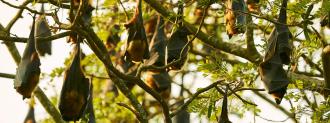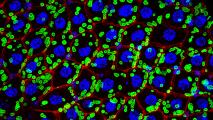With shades of Mary Shelley’s caged imagination, a handful of researchers in Singapore, trapped in lockdown by the pandemic, have turned their thoughts to an animal whose peculiar relationships with viruses may provide a clue for treating COVID-19: the bat.
Bats, while not our enemy, do happen to carry a number of diseases we consider particularly nasty — rabies, the fearsome Marburg and Ebola, and Hendra virus. But while these diseases are devastating in human beings, bats seem able to live with most of them just fine.
Could this ability, the scientists wondered, provide insights into treating COVID-19?
Treating COVID-19: Clues on Leathery Wing
University of Rochester researchers Vera Gorbunova and Andrei Seluanov found themselves in Singapore in March, before the lockdowns began. Caught up in the COVID-19 response, the married biology professors quarantined with Brian Kennedy, director of the Centre for Healthy Aging at the National University of Singapore.
Gorbunova and Seluanov have studied disease resistance and lifespan in numerous long-lived mammals, including the hideously odd naked mole rat. The trio of scientists got to talking about bats, which (despite their virus-riddled reputation) can live up to 30 years.
“We’ve been interested in longevity and disease resistance in bats for a while, but we didn’t have the time to sit and think about it,” Gorbunova told the University, in a press release.
“Being in quarantine gave us time to discuss this, and we realized there may be a very strong connection between bats’ resistance to infectious diseases and their longevity. We also realized that bats can provide clues to human therapies used to fight diseases.”
In a review article published in Cell Metabolism, researchers outlined how bat’s longevity and disease resistance might help doctors treating COVID-19 and other pandemic viruses.
According to Seluanov, while there have been studies on bat’s immune systems and long lives, this is the first article that considers the two together.
Bats are unusual, to say the least. Wildly diverse, highly social, and gifted with the unique-for-a-mammal ability of flight, bats also live unusually long lives for their size. Generally speaking, the smaller the creature, the shorter the life, but some bats live for decades.
And when it comes to viruses, bats have adapted to reduce both viral replication and inflammation.
Gorbunova and Seluanov have found inflammation to be consistently key in aging and age-related diseases. Alzheimer’s, cancers, rheumatoid arthritis, and cardiovascular disease all cause inflammation.
Evidence suggests that COVID-19’s unusual immune response — basically, it runs roughshod in a cell, while letting it call for immune system reinforcements as much as it wants — can lead to a cytokine storm. Caused by an immune reaction gone haywire, a cytokine storm can be fatal.
Inflammation is one of the key effects of the storm.
Flight and Friends
The question, then, is how do bats do it? What makes them able to tamp down inflammation?
One possibility is their hallmark ability: flight. Being able to fly requires an animal to be able to handle rapid temperature changes in their body, explosive surges in metabolism (flying is hard!), and molecular damage. Like how Aquaman’s adaptations to the deep sea make him super strong and durable on land, perhaps being able to handle the rigors of flight have also helped the bats resist viruses.
When it comes to viruses, bats have adapted to reduce both viral replication and inflammation.
Bats’ tendency to live in dense colonies, packed in cheek-by-wing and carpeting their homes with guano, could be another factor.
“Bats are constantly exposed to viruses,” Seluanov told the University of Rochester. “They are always flying out and bringing back something new to the cave or nest, and they transfer the virus because they live in such close proximity to each other.”
That constant flow of viruses means their immune system is always fighting; this evolutionary arms race may have helped develop their enviable ability to fight without triggering too much inflammation — and in turn, live longer lives.
Going Batty
Humans, the researchers argue, are moving towards behavior patterns that resemble bats. We cluster together in dense communities, and travel — using our own gift of flight — across vast distances, potentially exposing ourselves to new viruses, which we then pass on to others.
When considering this social trend and the role inflammation and age plays in COVID-19, studying the bat’s immune system could provide targets for new ways of treating COVID-19. The inflammation-associated genes that bats have mutated or completely gotten rid of could potentially be inhibited in humans, for example.
“Humans have two possible strategies if we want to prevent inflammation, live longer, and avoid the deadly effects of diseases like COVID-19,” Gorbunova said. “One would be to not be exposed to any viruses, but that’s not practical. The second would be to regulate our immune system more like a bat.”
By adapting batty methods, the researchers propose, we may be able to better fight for our pandemic future.






